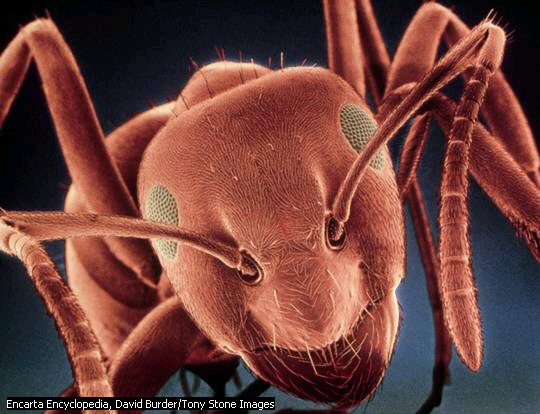 for
the feeding, shelter, and reproduction of the colony are divided
among specially adapted individuals.
for
the feeding, shelter, and reproduction of the colony are divided
among specially adapted individuals.Ants
Ant is the common name for
members of a family of about 9,000 species of insects that live in
highly organized societies called colonies. Ant colonies have
elaborate social structures in which the various activities necessary  for
the feeding, shelter, and reproduction of the colony are divided
among specially adapted individuals.
for
the feeding, shelter, and reproduction of the colony are divided
among specially adapted individuals.
Ants belong to an order of insects called the Hymenoptera, a group that also includes bees, wasps, and sawflies. Some species of wasps and bees resemble ants in that they live in colonies and are therefore said to be social, but ants are the only hymenopterans in which every species is social. Ants are distinguished from other hymenopterans in that they have bent, or elbowed, antennae and an indented abdomen that forms a narrow waist.
Ant colonies range in size from a few members to many millions of members. Members of an ant colony typically fall into categories known as castes, each with a different role. The majority of colony members are female worker ants that are unable to mate. Worker ants do not have wings and perform most of the work of the colony, including searching for food, nursing young, and defending the colony against ants from other colonies. Queens are larger than worker ants and are the only females of the colony capable of mating. Queens are born with wings, which they break off after mating. They mate with winged male ants, later using the sperm from the mating to produce fertilized eggs, which hatch to produce more worker ants and a new generation of queens. Aside from mating with the queens, males play no social role in colony life and die soon after mating.
Ants live on landmasses all over the world, except for the permanently frozen Arctic and Antarctic, the coldest mountaintops, and a few islands. They flourish in soil, rotting wood, leaf litter, dead trees, and living trees in such varied habitats as mountains, deserts, swamps, and human homes. Ants are most abundant in the tropical regions. In the rain forests of the Amazon, for instance, ants are so numerous that their total weight is about four times the weight of all the area’s mammals, birds, reptiles, and amphibians combined.
Ants play crucial roles in the ecosystems in which they live. Many species dig underground nests that have numerous openings and tunnels. Air and water pass into the soil through these passageways, making oxygen and moisture available to the roots of plants. Seed-eating ants remove seeds from plants and transfer them to underground storage chambers within their nests. This activity disperses the seeds, so that some of them can sprout in areas that are distant from the parent plants. Ants of many species feed on other insects, which may be either living or dead. In this way, ants reduce the size of some other insect populations and recycle organic matter. In turn, ants are a source of food for other animals, such as spiders, other insects, woodpeckers, and blue jays; toads, salamanders, and turtles; and anteaters, armadillos, and aardvarks. A few ant species are considered pests because they sting, invade human houses and yards, or damage wooden buildings.